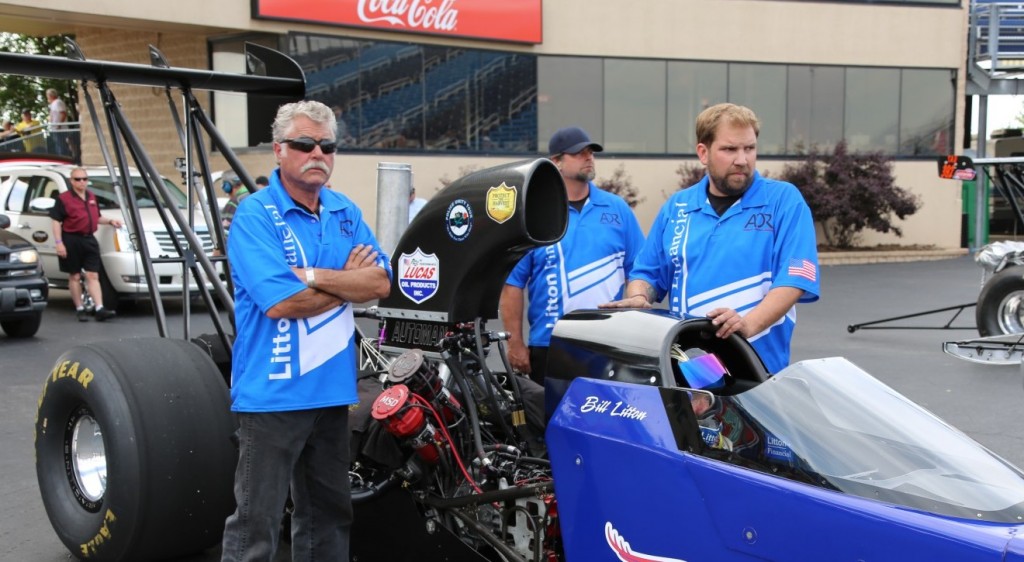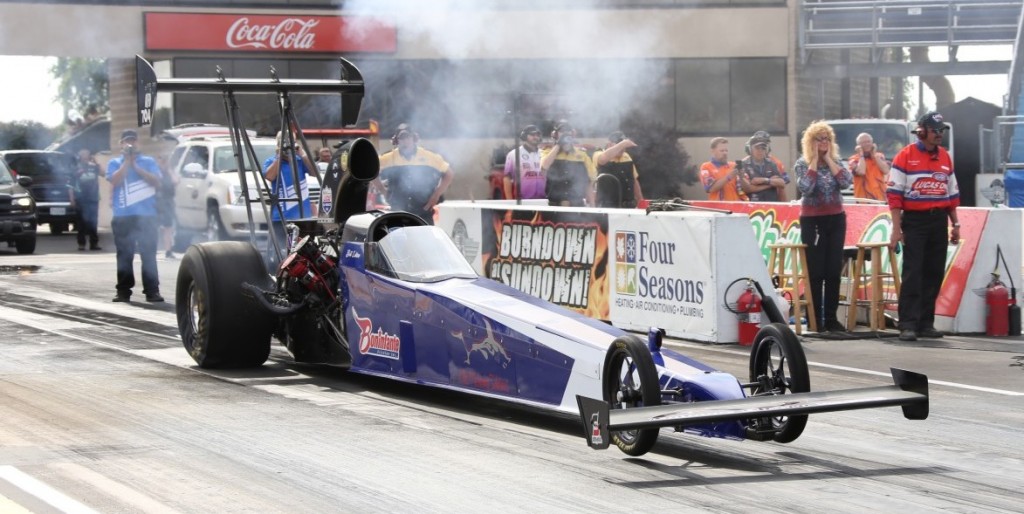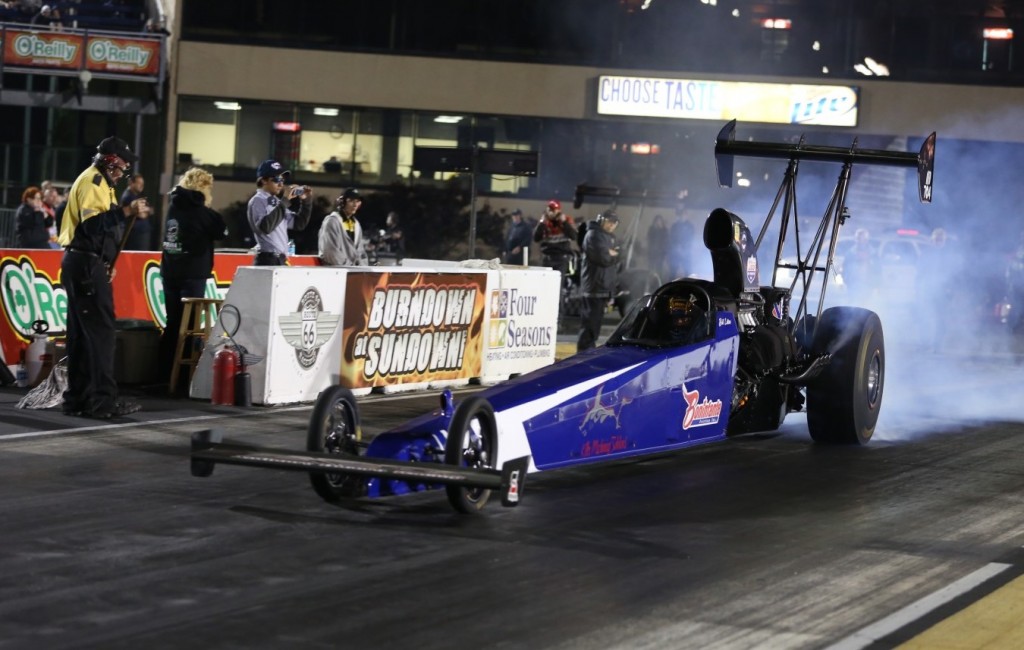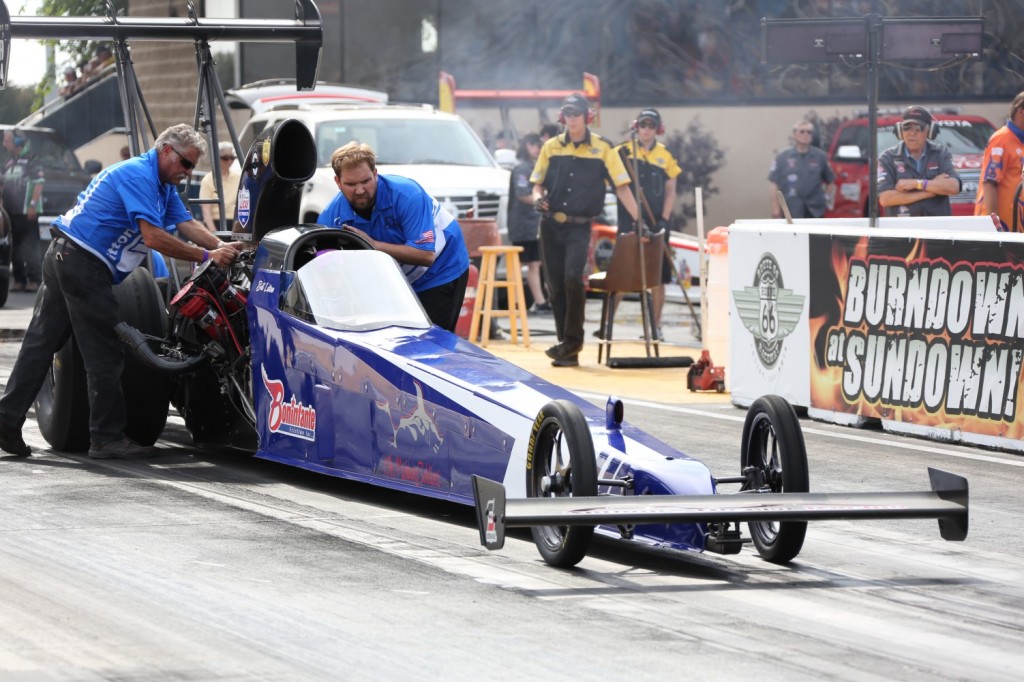NHRA Lucas Oil Series, Route 66 Raceway
Joliet, Illinois
June 7–9, 2013

Bill Litton was looking to become the hot-rod heavyweight in the Top Alcohol Dragster category at the NHRA Lucas Oil Drag Racing Series event in Joliet on June 7 -9. He and Crew Chief Anthony Dicero were “anxiously optimistic” for Thursday’s first qualifying run, and the weather seemed to be cooperating. With two new solid crew members on board, the car was purring for a high performance.The first run proved to be a wild ride for Litton with a little shake, rattle, and roll thrown in. Although the launch started out weak, the car gained a lot of acceleration at half-track. That’s when it started to shake, but Litton drove through it despite the fact that he temporarily lost his vision. “I stayed with it, and the vision came back really quickly. But while I had lost vision, the car moved just a few inches to the left and washed out of the groove. So I started feeling my way back to the groove and then my vision came back. I could see the finish line. I kept the throttle to the fire wall all the way through the finish line.” Times turned out to be decent but not what Dicero wanted at 5.69 and 260 MPH. Chief Dicero discovered the problem was a fuel-pressure leak – something that was overlooked in the pits. “The only thing we didn’t switch over was the air-pressure curve that regulates how much fuel pressure the motor sees. We had a fuel-pressure leak in the system that allowed the motor to not have as much fuel as it needed.”

Hopes were high for the second qualifying run. The Litton dragster showed promise with improved times of 5.67 at 258 MPH. In fact, the first couple of seconds Litton’s times were as good as his career best. But the car started to haze the tires and it dropped a cylinder, so the car didn’t make enough power to rise in the rankings.
The third and final qualifying round was set to happen around 8 pm, but the schedule kept getting pushed back due to a series of track oil downs. That proved to be a pivotal pitfall. When the Litton car finally made it to the starting line two and a half hours later, conditions had changed drastically. The tune-up had been tailored for warmer track conditions, but it was too late to change it up. So what the crew had tuned for no longer existed when the run actually occurred. The result? The car smoked the tires. From Litton’s perspective, “Right when I slapped the throttle to the fire wall, the rear end just raised up, so that meant the tires were stretched out and just spinning and I didn’t feel the G force. So I backed out of it, and disappointingly just coasted to the finish line.”
Litton ended up at slot 10 out of 17 cars, but the team needed to be at slot 8 to get into the elimination round. This was an especially difficult race, with everyone within a few hundredths of a second in qualifying. Dicero admits the competition was tough. “There were some bad hombres here. We walked out of here in tenth spot, which is not what we were looking to do.

But this is not easy, we’re learning a lot.”
One of the reasons this sport is so challenging is that rules don’t allow computers to control the car during the run. It is mainly for this reason that even the best-funded teams can find themselves in a slump from “losing their tune up.” If onboard computers were allowed to make changes during the run, an onboard computer would probably emerge that could make instantaneous adjustments to timing, fuel pressure, etc., as the car progressed down the track based on the traction available. But in the sport of NHRA drag racing, it’s all up to the inner brain wiring of the crew chief to figure out the ever-changing puzzle caused from changes in air temperature, track temperature, water grains in the air, density altitude, the number of runs made on the tires, and several other factors. So every run has a built-in variability which keeps the competition as sharp-edged as a Samurai sword.
To look at it another way, in football and other stick and ball sports, half the competitors win and half the competitors lose. In drag racing, there’s only one person who takes home a victory, sometimes out of 20 cars. In golf, imagine having to land the ball within two feet of the hole on every green stroke with no do-overs – almost an impossible task. Considering those examples, you start to get a sense of how steep the competition is every run down the track.
But with the addition of crew members Mike Civelli and Dustin Gatliff, the odds just got better. Civelli has been racing for more than 46 years and even had a documentary made about him and his team called Fast Lane Summer. Dustin Gatliff grew up in the sport of dragster racing and has worked with big-name teams including Morgan Lucas, John Force, Don Prudhomme, Scotty Cannon, and Don Schumacher.

Driver, chief, and crew are back at Route 66 Raceway at the end of the month (June 27 – 30) when North Central Division racers will join the NHRA Mello Yello Drag Racing Series for the O’Reilly Auto Parts NHRA Route 66 Nationals. As they gear up for their return, Dicero summed it up this way: “We’ll live to race another day. And they know we’re coming. We want to make this Litton Financial/Anthony Dicero race car a household name.”

